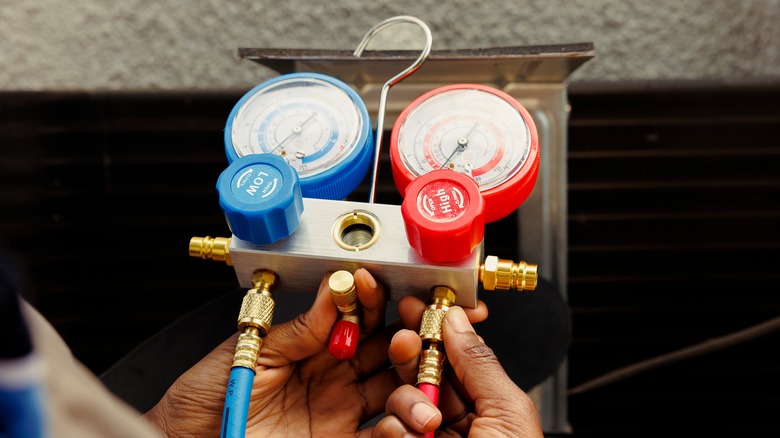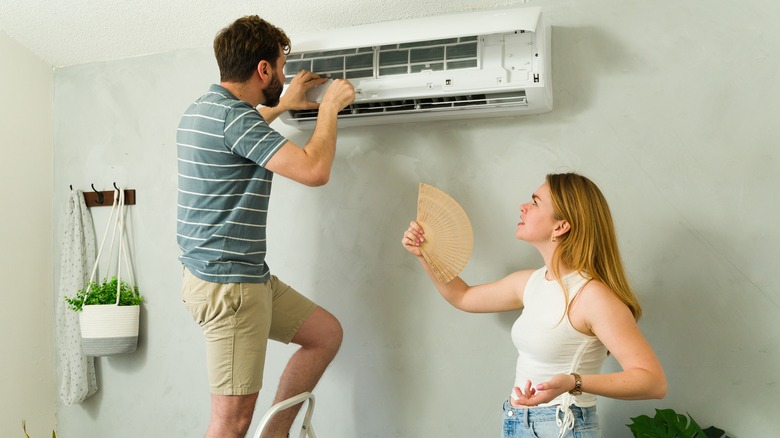Avoid Any HVAC DIYs Or You'll Regret It
DIY isn't just practical. It's also a lot of big things... a philosophical stance, a personal responsibility, and occasionally a matter of freedom. DIY projects are an objective good, so when you run across things that aren't appropriate weekend homeowner jobs, it's natural to be suspicious. It's natural to wonder if the HVAC pros are trying to keep you from taking a bite out of their share of the economic pie.
And, of course, they are. Every HVAC website seems to have a page on it proclaiming the inevitability of disastrous DIY installations and repairs. But here's the problem: They are also often quite right, for some obvious reasons and some reasons more difficult to grasp. Of course, you already know you could make costly mistakes, void your system's warranty, violate local building codes, or even break the law with an unlicensed DIY installation. You'll be working in tight spaces, talking way over your head to suppliers (who might not even sell to you), and spending many hours getting yet another imaginary degree from the University of YouTube.
Not to mention the safety issues: dealing with line voltage wiring and natural gas; making decisions that could lead to carbon monoxide poisoning; potentially inviting allergens, bacteria, or mold into your home; drawing outdoor pollutants inside; or even poisoning yourself with refrigerant. And it's not just major installations that are fraught with DIY problems. Some repairs and maintenance are better left to the pros, including thermostat installation and calibration, replacing parts, finding and fixing leaks, and more. The risk of delaying an equipment replacement that really should be done immediately is reason enough to leave it to them.
The unforeseen inevitabilities of DIY HVAC work
Some of the reasons to avoid HVAC DIY projects are more subtle, but they can be illustrated by a very mundane idea: You'll need a bunch of unfamiliar tools to do HVAC work. These might include a torque wrench, a vacuum pump, and tools for pipe-cutting, tube-bending, and tube-flaring. You'll need to have (and know how to use) refrigerant gauges, a multimeter, leak detectors, and airflow monitors. All of these tools signify a very broad set of interdisciplinary skills that HVAC installers and repair persons must have: electrical work, plumbing, natural gas handling, metalwork, airflow testing, and more. You don't pick up these skills over a weekend, but over the course of a career.
All of the expertise, aggregated skills, and day-to-day immersion equip HVAC pros with the ability to anticipate problems, plan for the unforeseen, and troubleshoot effectively when DIYers can't even suss out the most common air conditioning failures or how to repair them. Their experience is the foundation of creative thinking and problem-solving. It takes into account the little details the rest of us don't know or think about. It could involve details that bolster efficiency, awareness of regulations and their reasoning, or the ability to make good purchasing decisions based on arcane calculations. Or it might be more immediate and concrete — like awareness of and access to specialized materials, a history that allows you to not only disassemble but to then reassemble, along with the attention to detail needed to look for shocks from capacitors and wires.
The special case of the DIY mini-split
Of course, maybe you have all the requisite skills and experience, or the confidence to not worry much about it. DIY is not a fringe thing, and it never was. The HVAC trade itself is a sort of proof of the value of old-school generalists. Nowadays, you can find supply houses that not only sell to unlicensed homeowners but have even integrated that fact into their names. It's not necessarily daft.
One area where DIY AC work has taken hold is in the installation and maintenance of ductless mini-split systems. Their design eliminates a lot of the complexities of a traditional system (ductwork and related airflow concerns, for example) and makes it so doable that you can now buy DIY-focused mini-split brands like MrCool at Lowes, Home Depot, and Ace Hardware. Mini-splits skirt around some difficulties very effectively; for example, the long fixed-length linesets of DIY split systems eliminate the need for refrigerant handling and related certification. On the other hand, they usually still require substantial electrical work and often a fair bit of carpentry. And those linesets will need to be coiled up and hidden, perhaps alongside your condenser unit behind a flower bed.
Mini-splits blur the old distinction between whole-home solutions (typically reserved for professionals) and room-based units that are often the province of DIYers. You might take courage from this. Just keep in mind that when you're faced with an anomaly like, say, a mini-split not installed on an exterior wall, you're about to face issues with condensation and drainage that you might not be prepared for. Ask us how we know.


